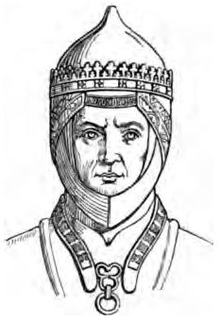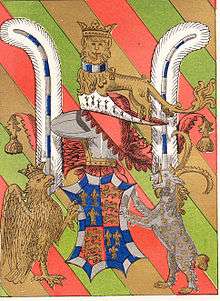John Beaufort, 1st Duke of Somerset
John Beaufort, 1st Duke of Somerset KG (1404 – 27 May 1444) was an English nobleman and military commander[1] during the Hundred Years' War.
John Beaufort | |
|---|---|
| Duke of Somerset | |
 Drawing of his tomb effigy | |
| Earl of Somerset | |
| Predecessor | Henry Beaufort, 2nd Earl |
| Successor | Edmund Beaufort, 4th Earl |
| Baptised | 25 March 1404 |
| Died | 27 May 1444 (aged 40) |
| Buried | Wimborne Minster church |
| Family | House of Beaufort |
| Spouse | Margaret Beauchamp of Bletso |
|
Issue
Margaret Beaufort, Countess of Richmond and Derby | |
| Father | John Beaufort, 1st Earl of Somerset |
| Mother | Margaret Holland |
Family
Baptised on 25 March 1404, he was the second son of John Beaufort, 1st Earl of Somerset, and Margaret Holland, and succeeded his childless elder brother Henry Beaufort, 2nd Earl of Somerset, to become the 3rd Earl of Somerset in 1418. He was also the 1st Earl of Kendal.
French Campaign
The young earl fought in his cousin Henry V's 1419 campaigns in France. In 1421, he accompanied the king's younger brother (also John's step-father) Thomas of Lancaster, Duke of Clarence, to the fighting in Anjou. Thomas was killed at the Battle of Baugé, while Somerset and his younger brother were captured. On 25 March 1425, Somerset came into his majority, but the estates of his father had to be managed by his mother for the next thirteen years until he was released from imprisonment.
He remained imprisoned until 1438, and after being ransomed, became one of the leading English commanders in France.[2]
Duke of Somerset: a soldier

In 1443, John was created Duke of Somerset and Earl of Kendal, made a Knight of the Garter, and appointed Captain-General of Guyenne. He married Margaret Beauchamp of Bletso in 1439. He presided over a period during which England lost much territory in France, and he proved a poor commander. Humphrey, 1st Duke of Gloucester, the regent for the young King Henry VI, was unable to control the administration of justice and finance, which led to widespread lawlessness. At the beginning of the second protectorate of Richard, Duke of York, Gloucester declined the post of Lieutenant-Governor, which was offered instead to Somerset. From this post, he drew a salary of 600 pounds and was Lieutenant-General for war even after York's appointment on 2 July 1440.
Somerset was appointed Admiral of the Sea to Lord Talbot's army command.[4] Talbot besieged Harfleur from August 1440, which for five months had been in French hands. King Charles VII of France sent a large army under Richemont. The English dug a double ditch rampart with only 1000 men, while Somerset's squadron prevented a French landing by sea, using archers to pick off the enemy at short range. Frustrated, the French withdrew to Paris, lifting the siege. The town surrendered to the English and was re-occupied. York was incensed that John's uncle, Cardinal Henry Beaufort, should advise the king to sue for peace. Somerset advised King Henry that peace was humanitarian and that the king of France was determined to seize Pontoise.[5] When York arrived in Normandy in 1441 to campaign, Somerset had resigned. But the fall of Pontoise to the Duke of Orléans in September 1441 weakened English garrisons, and in Gascony, the situation was even worse.[6] The Beauforts sent Sir Edward Hull, who arrived at Bordeaux on 22 October 1442 to inform York that a huge army would arrive commanded by Somerset. York was ordered to fortify Rouen; just as the king and Dauphin of France were threatening Bordeaux and Aquitaine and seized the town of Dax. Somerset dithered; York was held back as Guyenne was being lost.

Meanwhile, the Duke of York, fighting alongside the tactician Lord Talbot, had been appointed Lieutenant for all France. With the Duke of Gloucester's wife Eleanor charged with treason, Somerset took the opportunity in April 1443 to declare himself Lieutenant of Aquitaine and Captain-General of Guyenne. By then, the negotiations Somerset had started as Captain-General of Calais had failed. These two factors turned York against the Beauforts. But the last straw was the payment of £25,000 to Somerset while York remained heavily in debt. Furthermore, Guyenne was consuming precious resources otherwise destined for Normandy.[7]
In August 1443, Somerset led 7,000 men to Cherbourg and marched south to Gascony; the duke was ill. He blundered into Guerche, a Breton town with which England had signed a peace treaty. But Somerset set all prisoners free, accepting money from the Duke of Brittany. Marching aimlessly through Maine, he returned that winter to England.[8] His death in 1444 may have been suicide.[1][9] His death, and that of his uncle the cardinal, marked the end of Beaufort influence, and left the door open for William de la Pole, 1st Duke of Suffolk, to dominate government.[10] But the lasting effect of these events was burning resentment between the House of York and the remaining members of the Beaufort family.
Titles and styles
- 1st Duke of Somerset (28 August 1443 – 27 May 1444)[11]
- 1st Earl of Kendal (28 August 1443 – 27 May 1444)[11]
- 3rd Earl of Somerset (25 November 1418 – 27 May 1444)[12]
Children
Illegitimate children of John Beaufort:
- Tacine of Somerset. Being foreign born, she was made a denizen of England 20 June 1443. She married before 29 Sept. 1447 Reynold (or Reginald) Grey, 7th Lord Grey of Wilton. He was born about 1421 (aged 21 in 1442). They had one son, John, Knt. [8th Lord Grey of Wilton].
- John of Somerset (c. 1444–1453)
Child of John Beaufort and Margaret Beauchamp of Bletso:
- Lady Margaret Beaufort (31 May 1443 – 29 June 1509), mother of Henry VII
Ancestry
| Ancestors of John Beaufort, 1st Duke of Somerset | ||||||||||||||||||||||||||||||||||||||||||||||||||||||||||||||||||||||||||||||||||||||||||||||||||||||||||||||||||||||||||||||||||||||||||||||||||||||||||||||||||||||||||||||||||||||||||||||||||||||||||||||||||||||||||||||||||||||||||||||||||||||||||||||||||||||||||||||||||||||||||||||||||||||||||||||||||||||||||||||||||||||||||||||||||||||||||||||||||||||||||||||||||||||||||||||||||||||||||||||||||||||||||||||||||||||||||||||||||||||||||||||||||||||||||||||||||||||||||||||||||||||||||||||||||||||||||||||||||||||||||||||||||||||||||||||||||||||||||||||||||||||||||||||||||||||||||||||||
|---|---|---|---|---|---|---|---|---|---|---|---|---|---|---|---|---|---|---|---|---|---|---|---|---|---|---|---|---|---|---|---|---|---|---|---|---|---|---|---|---|---|---|---|---|---|---|---|---|---|---|---|---|---|---|---|---|---|---|---|---|---|---|---|---|---|---|---|---|---|---|---|---|---|---|---|---|---|---|---|---|---|---|---|---|---|---|---|---|---|---|---|---|---|---|---|---|---|---|---|---|---|---|---|---|---|---|---|---|---|---|---|---|---|---|---|---|---|---|---|---|---|---|---|---|---|---|---|---|---|---|---|---|---|---|---|---|---|---|---|---|---|---|---|---|---|---|---|---|---|---|---|---|---|---|---|---|---|---|---|---|---|---|---|---|---|---|---|---|---|---|---|---|---|---|---|---|---|---|---|---|---|---|---|---|---|---|---|---|---|---|---|---|---|---|---|---|---|---|---|---|---|---|---|---|---|---|---|---|---|---|---|---|---|---|---|---|---|---|---|---|---|---|---|---|---|---|---|---|---|---|---|---|---|---|---|---|---|---|---|---|---|---|---|---|---|---|---|---|---|---|---|---|---|---|---|---|---|---|---|---|---|---|---|---|---|---|---|---|---|---|---|---|---|---|---|---|---|---|---|---|---|---|---|---|---|---|---|---|---|---|---|---|---|---|---|---|---|---|---|---|---|---|---|---|---|---|---|---|---|---|---|---|---|---|---|---|---|---|---|---|---|---|---|---|---|---|---|---|---|---|---|---|---|---|---|---|---|---|---|---|---|---|---|---|---|---|---|---|---|---|---|---|---|---|---|---|---|---|---|---|---|---|---|---|---|---|---|---|---|---|---|---|---|---|---|---|---|---|---|---|---|---|---|---|---|---|---|---|---|---|---|---|---|---|---|---|---|---|---|---|---|---|---|---|---|---|---|---|---|---|---|---|---|---|---|---|---|---|---|---|---|---|---|---|---|---|---|---|---|---|---|---|---|---|---|---|---|---|---|---|---|---|---|---|---|---|---|---|---|---|---|---|---|---|---|---|---|---|---|---|---|---|---|---|---|---|---|---|---|---|---|---|---|---|---|---|---|---|---|---|---|---|---|---|---|---|---|---|---|---|---|---|---|---|---|---|---|---|---|---|---|---|---|---|---|---|---|---|---|---|---|---|---|---|---|---|---|---|---|---|---|---|---|---|---|---|---|---|---|---|---|---|---|---|---|---|---|---|---|---|---|---|---|---|---|---|---|---|---|---|---|---|---|---|---|---|---|---|---|---|---|---|---|---|---|---|---|---|---|---|---|---|---|---|---|---|---|---|---|---|---|---|---|---|---|---|---|---|---|---|---|---|
| ||||||||||||||||||||||||||||||||||||||||||||||||||||||||||||||||||||||||||||||||||||||||||||||||||||||||||||||||||||||||||||||||||||||||||||||||||||||||||||||||||||||||||||||||||||||||||||||||||||||||||||||||||||||||||||||||||||||||||||||||||||||||||||||||||||||||||||||||||||||||||||||||||||||||||||||||||||||||||||||||||||||||||||||||||||||||||||||||||||||||||||||||||||||||||||||||||||||||||||||||||||||||||||||||||||||||||||||||||||||||||||||||||||||||||||||||||||||||||||||||||||||||||||||||||||||||||||||||||||||||||||||||||||||||||||||||||||||||||||||||||||||||||||||||||||||||||||||||
Notes
- Tipping 1885.
- Harriss, G.L. (1988). Cardinal Beaufort: A Study of Lancastrian Ascendancy and Decline. Oxford: Clarendon Press.CS1 maint: ref=harv (link)
- Planché, J.R. (1852). Pursuivant of Arms. p. xx.CS1 maint: ref=harv (link)
- Burne 2005, p. 422.
- Burne 2005, p. 426.
- Jacob 1961, p. 470.
- Jacob 1961, p. 468.
- Burne 2005, p. 435–6.
- Harriss 2004.
- Burne 2005, p. 438.
- Cokayne 1953, p. 47.
- Cokayne 1953, p. 45.
- Weir 2008, p. 92.
- Weir 2008, p. 232.
- Brown 2004.
- Weir 2008, p. 93.
- Weir 2007, p. 6.
- Marshall 2003, p. 50.
- Browning 1898, p. 288.
- Weir 2008, p. 125.
- Weir 2008, pp. 94–95.
- Weir 2008, pp. 97, 104.
- Weir 2008, pp. 94, 125.
- Weir 2008, p. 77.
References
- Brown, M.H. (2004). "Joan (d. 1445)". Oxford Dictionary of National Biography (online). Oxford University Press. doi:10.1093/ref:odnb/14646. Missing or empty
|url=(help)CS1 maint: ref=harv (link) - Browning, Charles H. (1898). The Magna Carta Barons and Their American Descendants. London: Genealogical Publishing Company.CS1 maint: ref=harv (link)
- Burne, A.H. (2005). The Hundred Years War. London: Folio.CS1 maint: ref=harv (link)
- Cokayne, G. (1953). G.H. White (ed.). The Complete Peerage. 12.1 (2nd ed.). London: St. Catherine Press.CS1 maint: ref=harv (link)
- Harriss, G.L. (2004). "Beaufort, John, duke of Somerset (1404–1444), magnate and soldier". Oxford Dictionary of National Biography (online). doi:10.1093/ref:odnb/1862. Archived from the original on 7 February 2019.CS1 maint: ref=harv (link)
- Jacob, E.F. (31 December 1961). The Fifteenth Century 1399–1485. Oxford History of England. 6. Oxford: Clarendon Press. ISBN 978-0-19-821714-5.CS1 maint: ref=harv (link)
- Marshall, Rosalind (2003). Scottish Queens, 1034–1714. Tuckwell Press.CS1 maint: ref=harv (link)
- Weir, A. (2007). Mistress of the Monarchy: The Life of Katherine Swynford, Duchess of Lancaster. London: Random House. ISBN 978-0-345-45323-5.CS1 maint: ref=harv (link)
- Weir, A. (2008). Britain's Royal Families: The Complete Genealogy. London: Vintage Books. ISBN 978-0-09-953973-5.CS1 maint: ref=harv (link)
Further reading
- Griffiths, R.A. (1981). The Reign of King Henry VI. London: Ernest Benn. ISBN 0-510-26261-9.CS1 maint: ref=harv (link)
- Harriss, G.L. (1988). Cardinal Beaufort: A Study of Lancastrian Ascendancy and Decline. Oxford: Clarendon Press. ISBN 0-19-820135-4.CS1 maint: ref=harv (link)
- Jones, Michael K. (1981). "John Beaufort, Duke of Somerset, and the French Expedition of 1443". In R.A. Griffiths (ed.). Patronage, the Crown and the Provinces in Later Medieval England. Stroud: Sutton Publishing. pp. 79–102. ISBN 0-904387-45-3.CS1 maint: ref=harv (link)
- Jones, Michael K. (1982). The Beaufort family and the war in France, 1421–1450 (PDF) (PhD). University of Bristol. OCLC 71194555.CS1 maint: ref=harv (link)
External links
- Lundy, Darryl (ed.). "John Beaufort, 1st Duke of Somerset". The Peerage.
- "Duke of Somerset". Shakespeareandhistory.com.
- A page in his memory including a picture of his grave: https://www.findagrave.com/memorial/18690
| Peerage of England | ||
|---|---|---|
| New creation | Duke of Somerset 1st creation 1443–1444 |
Extinct |
| Earl of Kendal 1443–1444 | ||
| Preceded by Henry Beaufort |
Earl of Somerset 1418–1444 |
Succeeded by Edmund Beaufort |
.svg.png)